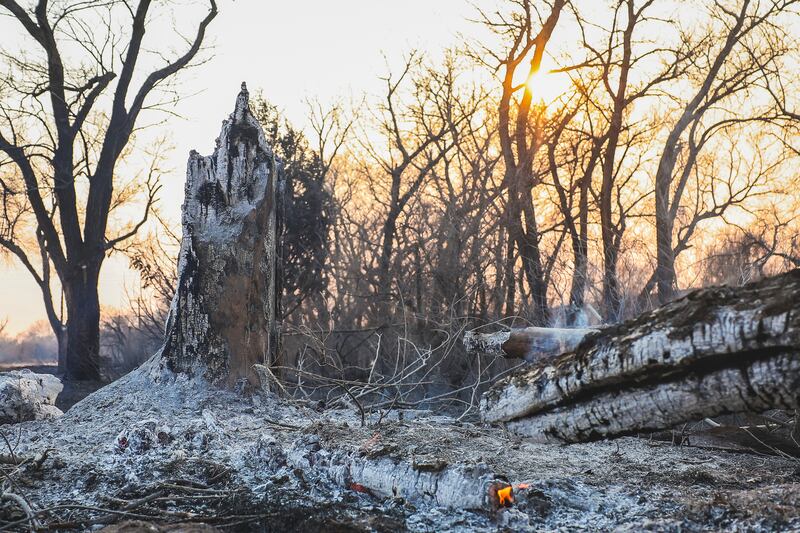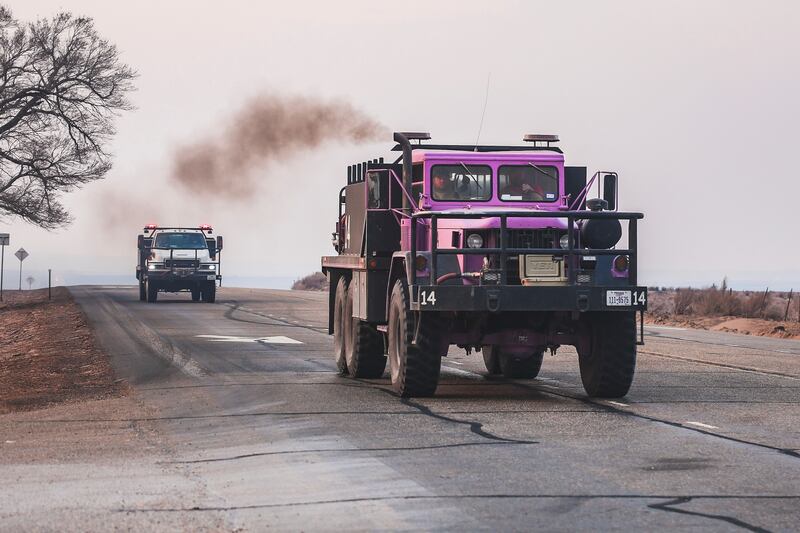A wildfire spreading across the Texas Panhandle has become the largest in state history, as a dusting of snow covered scorched grassland, dead cattle and burned out homes and gave firefighters a brief respite amid desperate efforts to control the blaze.
The Smokehouse Creek fire has grown to more than 4,400 sq km. It merged with another fire and is just 3 per cent contained, according to the Texas A&M Forest Service.
Grey skies from early cloud cover and the snow painted a bleak landscape: miles of blackened grassland, charred houses that still smouldered, dead cattle burned and stiff in the cold.
The Smokehouse Creek fire’s explosive growth slowed as snow fell and winds and temperatures dipped, but it was still untamed and threatening. It is the largest of several major fires burning in the rural Panhandle section of the state, and has crossed into Oklahoma.
READ MORE

Authorities said 4,200 sq km of the fire were on the Texas side of the border. Previously, the largest fire in recorded state history was the 2006 East Amarillo Complex fire, which burned about 3,600 sq km and resulted in 13 deaths.
Firefighters have made little progress taming the Smokehouse Creek blaze, but Thursday’s snow, rain and temperatures in the 40s offered a brief chance to make progress before temperatures and winds increase again on Friday and into the weekend.
Authorities have not said what ignited the fires, but strong winds, dry grass and unseasonably warm temperatures fed the flames.
Less than an inch of snow is expected, but moisture is not the only benefit, said National Weather Service meteorologist Samuel Scoleri.
“It will help keep relative humidity down for the day, and that will definitely help firefighters,” he added.
An 83-year-old woman is the only confirmed death so far, but with flames still menacing a wide area, authorities have yet to conduct a thorough search for victims or tally the numerous homes and other structures damaged or destroyed.

Nim Kidd, chief of the Texas Division of Emergency Management, said the weekend forecast and “sheer size and scope” of the blaze are the biggest challenges for firefighters.
“I don’t want the community there to feel a false sense of security that all these fires will not grow any more,” he said. “This is still a very dynamic situation.”
This week, walls of flame were pushed by powerful winds while huge plumes of smoke billowed hundreds of feet in the air across the sparsely populated region. The smoke delayed aerial surveillance of the damage in some areas.
“There was one point where we couldn’t see anything,” said Greg Downey (57) describing his escape as flames bore down on his neighbourhood. “I didn’t think we’d get out of it.”
The woman who died was identified by family members as Joyce Blankenship, a former substitute teacher.
Her grandson, Lee Quesada, said he had posted in a community forum asking if anyone could locate her. He said deputies told his uncle on Wednesday that they had found her remains in her burned home.
Republican governor Greg Abbott issued a disaster declaration for 60 counties.
Hemphill County emergency management co-ordinator Bill Kendall described the charred terrain as “like a moonscape. It’s just all gone”.
He said about 40 homes were burned around the perimeter of the town of Canadian, but no buildings were lost. Mr Kendall said he also saw “hundreds of cattle just dead, laying in the fields”.
The small town of Fritch, north of Amarillo, lost hundreds of homes in a 2014 fire and appeared to have been hit hard again. Mayor Tom Ray said on Wednesday that an estimated 40-50 homes had been destroyed on the southern edge, and natural gas remained shut off for the town of 2,200.
The Smokehouse Creek Fire spread from Texas into neighbouring Roger Mills County in western Oklahoma, where officials encouraged people in the Durham area to flee. At least 13 homes burned in fires in the state’s Panhandle region, officials said on Wednesday. – AP















